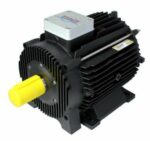- Südstraße 19 - 57583 Nauroth (Germany)
- +49 (0)2747 / 930585
- info@braun-windturbinen.com
Generators
Powerful, brushless and gearless, as well as maintenance-free permanent magnet generators!
NdFeBo permanent magnets, these are the strongest permanent magnets currently in existence. Cogging torque and maintenance-free!
In order to ensure a long and maintenance-free operation of the generators in the ANTARIS wind turbine, the copper winding in the stator is designed in insulation class H (180°C)!
Since the repeller is attached directly to the generator shaft, BRAUN Windturbinen GmbH uses special ball bearings to protect the resulting axial and axial acts. Absorb radial forces safely.
The copper winding is inserted exclusively by hand. Despite advancing automation of other components of the generators (CNC production), manual work has been given priority here for good reason. It ensures a complete inspection of the processed insulating materials and thus meets the quality standards of BRAUN Windturbinen GmbH.
This also applies to the build-up of the magnetic field in the rotor (moving part of the generator), where the magnets are also inserted by hand with a final check of the polarity. In order to enable absolute attachment of the magnets, they are fixed in the grooved rotor with a high-strength adhesive. In addition, the entire rotor is encapsulated with impregnating resin, quality work “Made in Germany”.
The generators are used as battery chargers, in grid-parallel operation or also for heating heating elements (wind heating). The power range is 1.5 kW to 18.5 kW (max. 30.0 kW for short periods). Corresponding controls for this are also available (see picture gallery).
If you equip the generator with a diesel engine or similar. (combined heat and power plant), a transmission may be dispensed with, due to speed adjustment on the part of the generator!
Weight: 23 – 160kg
Foot attachment
Shaft diameter: 28 / 48 / 55 mm
Case Material: Aluminum
Cooling: Surface, Fan Wheel
Direction of rotation: any
Version: 10 – 24-pin (depending on size);
Degree of protection: IP55
Efficiency: 90 – 95%
The range of these generators is designed for wind and hydroelectric power plants! The efficiency remains almost constant over the entire speed range. In order to enable the wind turbine to start up easily at low wind speeds, the generators are designed to have no cogging torque. They are mainly used to feed into the grid at wind turbines and are matched to the Smart!wind and Power One (2.0 – 10.0 kW) in terms of their power range! The rotor diameter should be 2.50m – 7.00m!
Of course, we also manufacture generators with higher outputs and higher numbers of poles (for lower speeds), just ask us!
Animation
Documents
Generators for combined heat and power plants with grid feed-in
Power classes: 2500 watts
Speeds: 200 rpm at 250 VDC (open circuit voltage)
830 rpm at 590 VDC and 2500 watts mains feed
(Grid feed with 2500 Windy Boy)
The drive motor should have an output of 3-5 kW, at max. 2200 rpm.
The thermal output is approx. 6 kW!
Power classes: 3500 watts
Speeds: 200 rpm at 200 VDC (open circuit voltage)
850 rpm at 590 VDC and 3500 watts mains feed
(Grid feed-in with 3800 Windy Boy)
The drive motor should have a power. of 4-6 kW, at max. 2200 rpm.
The thermal output is approx. 8 kW!
The optimal heating support for a single-family home!
Permanent magnet generators with 6000 or 2 pcs 1700 Windy Boy for mains parallel operation!
The 16-pole generator is used in water wheels or wind turbines with low speed and is cogging-free!
Speed range with 2 pcs 1700 WB ́s (3.4 kW)
Idle
125 VDC at 97 rpm
160 VDC at 125 rpm.
320 VDC at 299 rpm
Working speed
224 VDC at 287 rpm and 1200 watts
350 VDC at 390 rpm & 3000 watts
Speed range with 1 pc. 6000 Windy Boy
Idle
125 VDC at 99 rpm.
520 VDC at 425 rpm.
Speed range for low-speed generators with 2.5 kW power
Idle
125 VDC at 50 rpm.
Technical design for the CK 11.0 kW generators
- Weight: 87 kg, aluminium body
- Shaft diameter 48 mm, BG 160
- 6-point foot attachment
- Reinforced bearing and shield design
- Cooling: Surface, Fan Wheel
- Direction of rotation: any
- Version: 10 – 16 poles; Degree of protection: IP56
- Efficiency: 91%
- Protection class: IP56
- Magnetic field up to 150°C
- Winding class (180°C)








